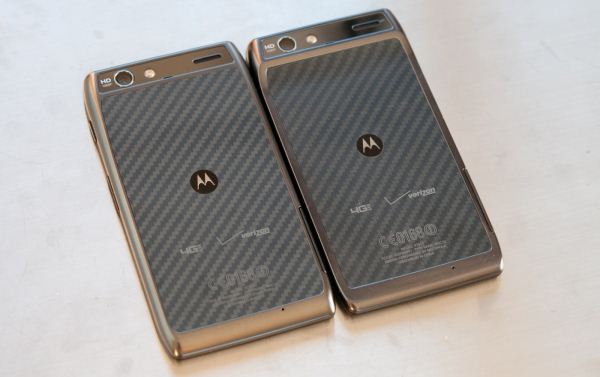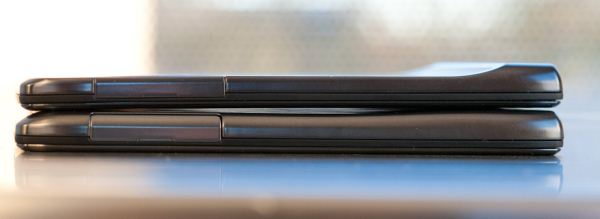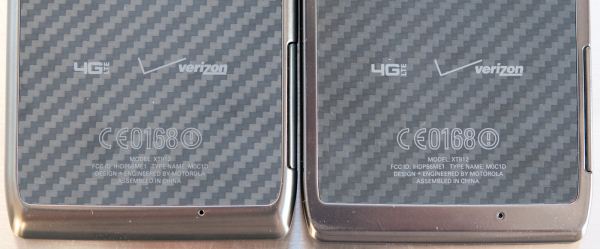Motorola Droid RAZR MAXX Review - 1.8x The Battery
by Brian Klug on February 14, 2012 2:01 PM EST- Posted in
- Smartphones
- Motorola
- Android
- Mobile
- motorola droid RAZR
- RAZR MAXX
- RAZR
Motorola Droid RAZR MAXX Review
For a while now, our chief complaint when talking about 4G LTE handsets has been battery life. The combination of 45nm cellular basebands, ever increasing screen size, and 4x nm SoCs has been unforgiving in the power department. Handset manufacturers are always engaged in a difficult balancing act between device size, price, and the resulting battery life. Too big of a battery and you’ve created a brick that looks unattractive next to other svelte phones, too small and you’ve created something that looks great but needs to be tethered to the wall all day.

Droid RAZR MAXX (left), Droid RAZR (right)
We’ve already reviewed the Motorola Droid RAZR, which itself is a close cousin of the Motorola Droid Bionic. As a result, we’re not going to go into super depth with the MAXX since it would be a 1:1 repeat in basically every part to what we talked about in the RAZR review already. The RAZR MAXX and RAZR are quite literally the exact same device (PCB, display, cellular basebands, camera, etc.) with the exception of battery and exterior case.
The two share the same model number (XT912), FCC-ID (IHDP56ME1), and run the same software. Motorola has talked about reducing the number of devices released yearly and consolidating down to just a few flagships, and though it’s easy to claim otherwise, the RAZR and RAZR MAXX don’t really confuse things that much since, again, they’re really the same phone with a different case and battery. The result of that similarity is that from a software and carrier testing perspective, delivering updates to one means delivering updates to the other, something we’ve already seen turn out to be the case with the recent 6.12.173 update.
What’s changed with the MAXX incantation is its battery, which is significantly larger. It seems as though Motorola has been feeling nostalgic about some of its old brands lately, reviving first the RAZR brand, and now the “MAXX” brand in the form of a moniker (anyone else remember the MOTORAZR MAXX?). In this case, what’s MAXX about the RAZR MAXX is its battery, which is 1.88 times the size of the RAZR battery. (As an aside, I can’t help but think of the Rage Fury MAXX every time I type MAXX)
The MAXX also continues use of Motorola’s higher voltage Li-ion chemistry, which is 3.8V nominal as opposed to the standard 3.7V nominal voltage. Motorola continues to use this higher voltage chemistry on a majority of its new devices. As I talked about in the Bionic and RAZR reviews, this means you can’t directly compare mAh, instead watt-hours is better for comparison purposes here. We’ve been careful about using Whr, and I only think in Whr anymore, which finally paid off with this jump to a higher voltage.
| LTE Smartphone Battery Size Comparison | ||||||
| HTC Rezound | CDMA/LTE Galaxy Nexus | Motorola Droid RAZR | Motorola Droid RAZR MAXX | |||
| Nominal Voltage | 3.7 V | 3.7 V | 3.8 V | 3.8 V | ||
| Capacity in mAh | 1620 mAh | 1800 mAh | 1750 mAh | 3300 mAh | ||
| Capacity in Watt-Hours | 5.99 Whr | 6.66 Whr | 6.65 Whr | 12.54 Whr | ||
Against the competition, the RAZR MAXX battery is positively huge, and is larger than the Bionic’s extended battery which itself was a hefty 10.2 Whr. The battery remains sealed inside and not easily replaceable, but given its size this is a totally acceptable trade-off. That’s really where the MAXX makes sense - if you’re going to sacrifice battery access and replaceability, it should be absolutely beyond a doubt big enough to make it through at least one day’s worth of constant abuse.

RAZR MAXX (bottom), RAZR (top)
The MAXX does put on some weight and get heftier in the midsection as a result, but the phone is still remarkably thin. What’s interesting is that although the RAZR MAXX is thicker than the RAZR at its thinnest point, the two phones’ thickest points are still the same. I guess that really illustrates what’s wrong with the way that OEMs are specifying device “thickness” these days more than anything, as most intentionally cite the device thickness at its thinnest point. One other OEM has told me it’s going to move to a mean thickness measurement, which seems to be more representative but potentially complicated. Personally, giving min and max seems to be the most honest disclosure, and again on the MAXX only the thinnest point gets thicker. Mass goes up 17 grams, just 13% over the RAZR.
| Physical Comparison | ||||
| Apple iPhone 4S | Samsung Galaxy Nexus (LTE) | Motorola Droid RAZR | Motorola Droid RAZR MAXX | |
| Height | 115.2 mm (4.5") | 135.5 mm (5.33") | 130.7 mm (5.15") | 130.7 mm (5.15") |
| Width | 58.6 mm (2.31") | 67.94 mm (2.67) | 68.9 mm (2.71") | 68.9 mm (2.71") |
| Depth | 9.3 mm ( 0.37") | 9.47 mm (0.37") | 7.1 mm (0.28") | 8.99 mm (0.35") |
| Weight | 140 g (4.9 oz) | 150 g (5.3 oz) | 127 g (4.5 oz) | 145 g (5.1 oz) |
| CPU | Apple A5 @ ~800MHz Dual Core Cortex A9 | 1.2 GHz Dual Core Cortex-A9 OMAP 4460 | 1.2 GHz Dual Core Cortex-A9 OMAP 4430 | 1.2 GHz Dual Core Cortex-A9 OMAP 4430 |
| GPU | PowerVR SGX 543MP2 | PowerVR SGX 540 | PowerVR SGX 540 | PowerVR SGX 540 |
| RAM | 512MB LPDDR2-800 | 1 GB LPDDR2 | 1 GB LPDDR2 | 1 GB LPDDR2 |
| NAND | 16GB, 32GB or 64GB integrated | 32 GB NAND | 16 GB NAND, 16 GB microSD class 4 preinstalled | 16 GB NAND, 16 GB microSD class 4 preinstalled |
| Camera | 8 MP with LED Flash + Front Facing Camera | 5 MP with AF/LED Flash, 1080p30 video recording, 1.3 MP front facing | 8 MP with AF/LED Flash, 1080p30 video recording, 1.3 MP front facing | 8 MP with AF/LED Flash, 1080p30 video recording, 1.3 MP front facing |
| Screen | 3.5" 640 x 960 LED backlit LCD | 4.65" 1280x720 SAMOLED HD | 4.3" 960 x 540 SAMOLED Adv. | 4.3" 960 x 540 SAMOLED Adv. |
| Battery | Internal 5.3 Whr | Removable 6.85 Whr | Internal 6.65 Whr | Internal 12.54 Whr |
In the hand, I find the MAXX to unsurprisingly feel very similar to the RAZR. The thickness change is obviously perceptible, but not a big deal. The RAZR remains a thin, flat device, and adding 2 mm at the thinnest point honestly doesn’t change the way that things feel to me. In the pocket, I think you’d have a hard time feeling the difference between the RAZR and the RAZR MAXX - neither print very much in a pair of jeans or dress slacks.
Interestingly enough the most notable change between the RAZR and the RAZR MAXX is that the two don’t lie flat the same way back down on a table. The RAZR tilts slightly thanks to that thickness difference, the RAZR MAXX is very close to being completely coplanar with the surface it’s resting on. The backside still has the slightly rubberized Kevlar material, though the curve at the top isn’t nearly as small. The microSD and microSIM door at the side gets a bit taller as well.
The RAZR MAXX is probably the first time I’ve seen a device offer a significantly larger battery without it being an obvious afterthought. The traditional extended battery upgrade path usually involves getting a new battery door with a huge, obvious, awkward bulge. Almost every single time, that battery door either doesn’t match or fit properly, or it’s just an awkward afterthought. The other upgrade option is usually a battery with the same volume but slightly more capacity. The MAXX is neither - a device with a notably bigger battery that doesn’t make all the concessions that normally accompany such an upgrade.

















45 Comments
View All Comments
DanNeely - Tuesday, February 14, 2012 - link
I can't say I've ever seen an extra bar on my phone from pulling the antenna out. I'm more than half convinced it's purely decorative.Rocket321 - Thursday, February 16, 2012 - link
heh...they better not include one of those AND try to put the headphone jack on the bottom!sholling - Tuesday, February 14, 2012 - link
This is by far the best Razr Maxx review that I've seen so far and if my contract were up I'd probably buy one once it gets ICS. It's not exactly what I want but it comes closer than anything else on the market right now. For what it's worth the improvements that I'd like to see for the RAZR Maxx II are quad-core for the energy sipping 5th core, a 4.5" 720 advanced SAMOLED display, and a built-in 32GB of storage with official support for add in 64GB microSD cards. It's rumored that they work now but official support is better. Admittedly I'm a power user but it would be nice to be able to store 30GB of high quality music plus photos, plus audiobooks, plus a huge 3rd party GPS app with on board maps. If it saves me having to pack a high-end GPS and a high capacity audio player along with my smartphone I'd pay a premium. Anyway I have high hopes that Motorola will release something along those lines this summer - just in time to renew my Verizon contract.One concern with the built in battery concept is that while I have no problem buying a new phone every two years for new technology I have a big problem having to get it fixed early because the battery capacity is down or even at 2 years because the battery is worn out. That's planned obsolesce like the 70s cars that fell apart as soon as the warranty was up. I've traditionally replaced my original batteries after 12 months and it sucks not to be able to do that.
Again a really nice review. Hard numbers (including the WHr conversion) like these trump the fluff I've seen elsewhere.
DanNeely - Tuesday, February 14, 2012 - link
According to iFixit the Droid Razr's battery isn't that hard to get at; so a DIY swap shouldn't be too hard if needed.sholling - Tuesday, February 14, 2012 - link
Thank you that's good information!pandemonium - Wednesday, February 15, 2012 - link
The battery life is rather disappointing for web browsing, however. Have you guys considered running the latest versions of Opera Mobile to see if there's a better subjective result across several different devices?I'm really curious to see how some of the Anna, Belle, and WP Nokia phones compare. I'm in the market for a new phone and the camera is the more important aspect of the device for me. It'd be nice to have AT broaden their testing platform to provide more comparison. :)
Brian Klug - Wednesday, February 15, 2012 - link
Have you seen our reviews of the Lumia 710 and 800?http://www.anandtech.com/show/5266/nokia-lumia-800...
http://www.anandtech.com/show/5284/nokia-lumia-710...
We usually do a pretty comprehensive job with the camera especially, this time because the MAXX is just a normal RAZR with bigger battery I went light on details.
-Brian
pandemonium - Wednesday, February 15, 2012 - link
I had forgotten you guys did that - my mistake! I also didn't see the N8 review you guys did early of '11. Considering how cheap an N8 is now (off-contract), that may be my phone of choice. Unless its successor will be unrealistically cheap.Any thoughts on using Opera for the browser life comparison?
EXCellR8 - Wednesday, February 15, 2012 - link
I picked one of these up over the weekend and have mostly good things to say. It was between this and the Nexus I opted for the droid because it had the bigger battery, better camera, and SD card. The battery does take awhile to fully charge, and I don't like some of the software that comes installed but those are minor grievances. I am anxious to upgrade to ICS but GB is fine for the time being. Overall it's a pretty nice phone, I would have liked a slightly bigger screen but the resolution is decent.I'd probably give the device a 4.5/5
ol1bit - Wednesday, February 15, 2012 - link
I like how the Rezound does on it's tinny battery. I guess I'll get the extended and beat the MAXX hands down looks like !